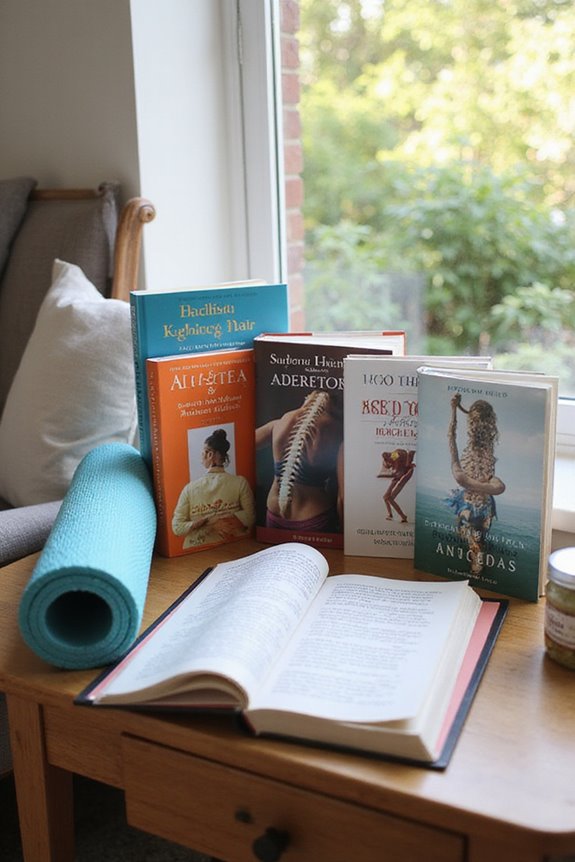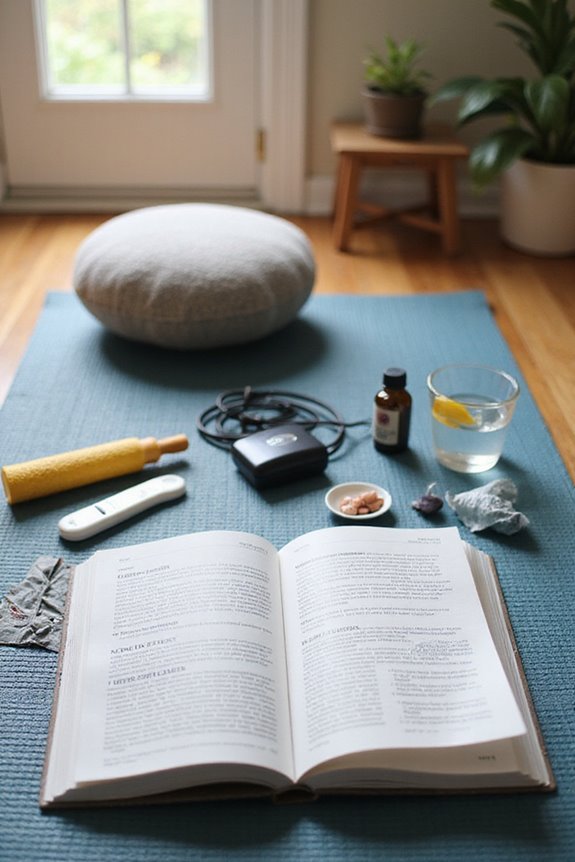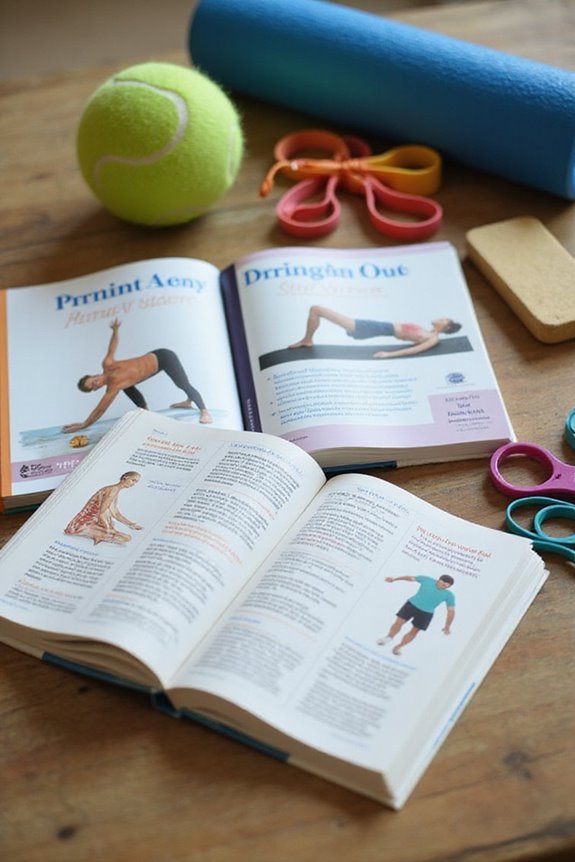The best exercise books for pain conditions include *Back Mechanic* and *Low Back Disorders*, which emphasize tailored exercises and rehabilitation strategies. Effective books present extensive educational content, step-by-step instructions, and holistic approaches. Titles like *8 Steps to a Pain-Free Back* and *Back Exercise by Brian Richey* focus on posture correction and strengthening. Resources also offer online classes and community support for chronic pain management. More insights can be discovered on specific exercises tailored to individual needs.
Key Takeaways
- *Back Mechanic* emphasizes personalized assessment and targeted exercises for effective pain management.
- The Video Enhanced Back Mechanic package offers visual instructions to ensure safe exercise practices.
- *Low Back Disorders* provides clinically validated strategies for prevention and rehabilitation of back pain.
- *8 Steps to a Pain-Free Back* focuses on practical lifestyle adjustments, particularly for posture correction.
- *Back Exercise by Brian Richey* highlights strengthening exercises specifically designed for chronic pain relief.
Overview of Exercise for Chronic Pain Management
Exercise plays an essential role in the management of chronic pain, particularly when it is tailored to individual needs and conditions. Various exercise modalities, including aerobic exercise, flexibility activities, and strength training, have been shown to improve pain management across conditions such as fibromyalgia and chronic low back pain.
Key points include:
- Supervised stretching and strengthening programs enhance function in non-specific chronic back pain.
- Low-impact activities like Tai Chi and Yoga benefit individuals with osteoarthritis and fibromyalgia.
- Accessible exercises, such as swimming and walking, can greatly reduce pain severity.
- Frequency of exercise sessions is vital; higher engagement correlates with improved outcomes.
- Careful prescription of exercise intensity and duration is essential for effectiveness.
These factors collectively contribute to enhanced quality of life for those experiencing chronic pain.
Key Features of Effective Pain Management Books

Effective pain management books are characterized by key features that enhance reader comprehension and application. These books typically include:
- Comprehensive Educational Content: Detailed explanations of pain mechanisms and self-management techniques such as pacing and relaxation improve pain education.
- Step-by-Step, Illustrated Exercise Instructions: Full-color illustrations clarify movements, while clear instructions facilitate safe and effective exercise motivation.
- Tailored Routine Prescriptions: Specific exercise routines and assessments guide users in tracking progress and customizing their approach.
- Holistic Approaches: Integration of psychological and lifestyle strategies addresses pain from multiple dimensions, enhancing overall well-being.
- Accessibility Features: Layman-friendly language and home-friendly exercises guarantee usability across diverse populations.
These elements collectively foster enhanced engagement and practical application of pain management strategies.
Recommended Books for Back Pain Relief

Numerous resources exist for individuals seeking relief from back pain, with several books recognized for their effectiveness.
- *Back Mechanic: The Step-by-step McGill Method to Fix Back Pain* emphasizes personalized assessment through self-evaluation, followed by targeted exercises for various conditions.
- The Video Enhanced Back Mechanicpackage complements this with visual instructions, facilitating understanding and execution.
- *Low Back Disorders: Evidence-Based Prevention and Rehabilitation* provides clinically validated strategies applicable to diverse settings.
- *Back Exercise by Brian Richey* focuses on strengthening exercises to manage chronic pain effectively.
- *8 Steps to a Pain-Free Back* offers practical lifestyle adjustments for natural posture correction.
These resources support progressive rehabilitation, equipping individuals with knowledge and tools to manage their back pain efficiently.
Stretching Techniques for Pain Reduction

Stretching techniques have emerged as a viable approach for reducing pain associated with various musculoskeletal conditions. Research indicates that chronic stretch training greatly enhances pain tolerance, leading to notable decreases in pain levels.
Key Findings:
- Interventions lasting 4 weeks to 6 months show improved range of motion and reduced muscle stiffness.
- Studies involving 658 participants report considerable pain score reductions after consistent stretching protocols.
- Acute stretching can provide immediate pain relief, especially in conditions like nurse headaches and anterior knee pain.
- Holding stretches for 30 seconds or longer optimizes comfort and flexibility.
Stretching Benefits:
- Regular stretching reduces muscle tension and discomfort.
- Targeting specific muscle groups can alleviate pain effectively.
Incorporating these techniques into daily routines can foster long-term relief from musculoskeletal pain.
Holistic Approaches to Chronic Pain

Holistic approaches to chronic pain management offer a thorough framework that integrates multiple therapeutic modalities, aiming to address the complexities of pain. Various holistic therapies provide an all-encompassing strategy for pain relief, including:
- Acupuncture: Stimulates nerves and muscles, potentially easing conditions like back pain and migraines.
- Chiropractic Care: Focuses on spinal alignment, often combined with exercise and massage for tailored pain relief.
- Massage Therapy: Manipulates soft tissues to enhance blood flow, providing immediate relief for various pain types.
- Nutrition: Advocates whole-food diets to reduce inflammation and supports overall health.
- Stress Reduction: Incorporates mindfulness and relaxation techniques to disrupt the pain-stress cycle, promoting better sleep and emotional well-being.
These integrative methods collectively enhance the effectiveness of pain management strategies.
The Role of Mental Health in Pain Management
The interplay between mental health and chronic pain is significant, as a substantial proportion of individuals with chronic pain also experience mental health disorders.
- Approximately 35% to 45% of these individuals experience depression.
- About 40% suffer from anxiety, with high rates of comorbidity.
- Over 55% report unremitted symptoms, far exceeding those without chronic pain.
Gaps in mental health care are notable; only 44.4% of people with chronic pain access necessary services, compared to 71.5% of those without.
Untreated mental health symptoms can worsen pain perception and reduce quality of life, emphasizing the importance of integrated care. Systematic mental health screening within pain management settings can facilitate timely interventions, ultimately enhancing overall treatment outcomes and patient well-being.
Targeted Exercises for Specific Pain Conditions
Targeted exercises play an essential role in managing specific pain conditions, offering tailored approaches that address the unique needs of individuals.
Chronic Neck Pain
- Cranio-cervical flexion exercises reduce local pain.
- Cervical flexion endurance exercises improve function.
Chronic Low Back Pain
- Supervised exercise therapy enhances pain and function.
- Strength and flexibility training reduce disability.
Fibromyalgia
– Aerobic training combined with flexibility and strength exercises decreases pain sensitivity.
Osteoarthritis
- Therapeutic exercises improve joint mobility and reduce inflammation.
- Low-impact aerobic exercises enhance cardiopulmonary health.
Complex Regional Pain Syndrome (CRPS)
– Graded therapeutic exercise improves function and reduces pain severity.
These targeted exercises are critical in addressing the multifaceted nature of pain conditions, promoting overall well-being and functional improvement.
Safety Tips for Exercising With Chronic Pain
Exercising with chronic pain necessitates a careful approach, as individuals must prioritize safety to avoid exacerbating their conditions.
Listening to the Body
- Pay attention to pain signals; modify or pause activity if symptoms worsen.
- Use a “start low, go slow” strategy to gradually increase intensity.
Safety Measures
- Implement exercise modifications to minimize fall risk and strain on joints.
- Guarantee proper posture and choose a comfortable range of motion.
Pacing and Activity Management
- Avoid overexertion by pacing activities, incorporating regular rest breaks.
- Spread exercise sessions evenly throughout the week.
Consultation
- Seek professional guidance for personalized exercise programs tailored to pain management.
- Regularly review exercise plans with healthcare providers to adjust as needed.
Long-term Benefits of Structured Exercise Programs
Structured exercise programs offer significant long-term benefits for individuals managing chronic pain conditions. These programs lead to:
- Improved Pain and Function: Regular moderate-intensity aerobic and resistance training results in sustained pain relief and enhanced physical function.
- Mood Enhancement: Exercise promotes endorphin release, reducing pain perception and improving mood, which is vital for mental well-being.
- Customized Approaches: Tailoring exercise to individual needs enhances adherence and effectiveness, addressing specific conditions like fibromyalgia or arthritis.
- Physiological Benefits: Regular activity lowers systemic inflammation and strengthens muscles, reducing biomechanical stress on joints.
- Comprehensive Management: Combining structured exercise with physical therapy provides a holistic approach to pain management.
These long-term benefits underscore the importance of structured exercise in improving the quality of life for those affected by chronic pain.
Additional Resources for Chronic Pain Management
While managing chronic pain can be challenging, a variety of additional resources are available to support individuals in their journey toward improved health and well-being.
Online and Virtual Exercise Classes
- Mayo Clinic Health System offers free multiweek exercise classes tailored for chronic pain, incorporating education and routine exercise.
- Classes run bi-monthly, twice weekly for four weeks, fostering consistency.
- Safety screenings are conducted to accommodate individuals with comorbid conditions.
Exercise Modalities
- Balance-enhancing exercises like yoga and tai chi improve stability.
- Hydrotherapy provides pain relief through buoyancy and warmth.
Comprehensive Resources
- The International Pain Foundation (iPain) offers educational webinars and support groups.
- Tailored, person-centered exercise resources enhance adherence and treatment success.
Frequently Asked Questions
Can I Use These Books Without a Healthcare Professional’s Guidance?
Can one navigate the world of exercise books independently? Self-guided safety becomes paramount; while independent practice may seem appealing, caution is essential. Consulting a healthcare professional guarantees personalized guidance, preventing the risk of exacerbating existing pain conditions.
Are There Exercise Modifications for Seniors With Chronic Pain?
Exercise modifications for seniors with chronic pain include gentle stretches and low-impact workouts, ensuring safety and comfort. These adaptations foster a sense of belonging in supportive communities, promoting overall health and enhancing quality of life through movement.
How Do I Choose the Right Book for My Specific Condition?
“An ounce of prevention is worth a pound of cure.” When selecting book recommendations for specific conditions, one should consider targeted content, expert endorsements, and practical features to guarantee effective and safe exercise practices that foster belonging and understanding.
What if I Experience Increased Pain During Exercises?
Experiencing increased pain during exercise may necessitate adjustments in exercise intensity for effective pain management. Individuals should consult professionals to guarantee exercises are safe, tailored to their needs, and supportive of their journey toward healing and belonging.
Can These Books Help With Pain Management for Athletes?
The books effectively support athlete recovery and pain prevention by integrating pain science with practical movement strategies. They empower athletes, fostering a sense of belonging through shared experiences and knowledge while promoting active engagement in their healing process.





